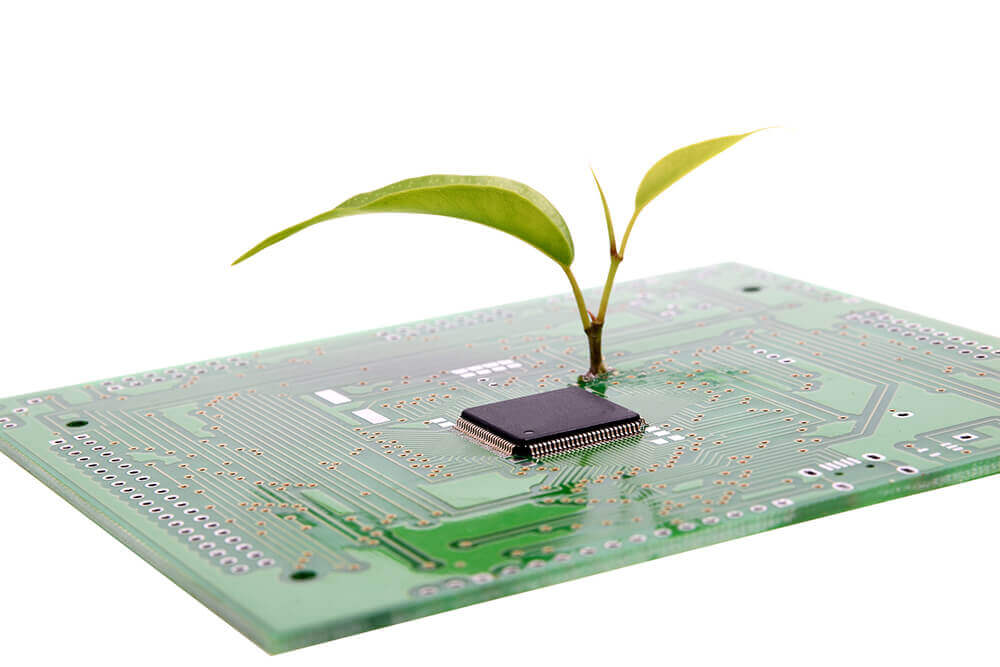The sustainability wave in the tech space is gaining momentum. Alphabet, Amazon, Apple, Facebook, and Microsoft have all set very aggressive sustainability targets (Figure 1). Most of these companies are shooting for net-zero emissions by 2030, or at least have Scope 1 and 2 emissions at zero at that time. Facebook and Apple have taken their sustainability efforts one step further and are asking their supply chains to significantly reduce, if not be 100% carbon neutral by 2030.
As environmentally cognizant people we nod our heads and say fantastic, and then realize that this applies to the entire semiconductor supply chain. According to Andy Byrne of Micron, semiconductors can account for 20-35% of a technology’s brands’ full value chain greenhouse emissions. This is not quite a wakeup call as many semiconductors OEM, equipment and material companies have been environmentally conscious for a significant period of time, but there are areas that need work, and where the industry needs to collaborate, to help to not only reduce the carbon footprint, but to reduce waste, and improve water conservation.
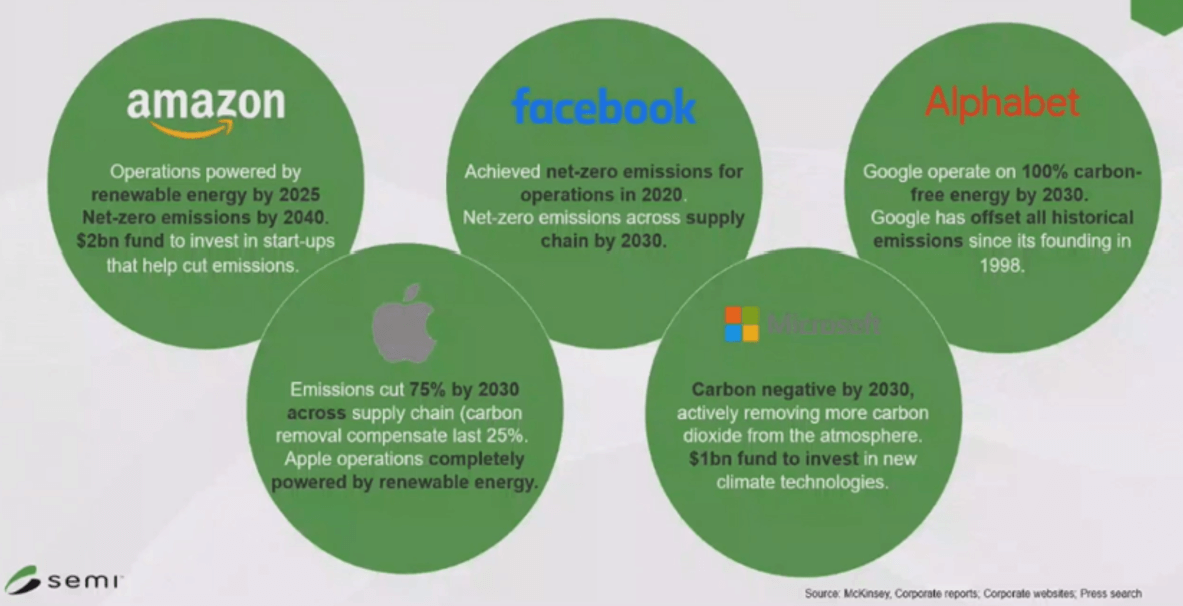
SEMI and Applied Ventures put on a one-day seminar, The SEMI Sustainable Venture Forum, that allowed some companies to showcase their efforts in the sustainability arena. Other presenters demonstrated that in some areas the industry has a long way to go to meet some of the goals put out by the United Nations Sustainability Development Goals, and the Kyoto and Paris accords.
I think one of the venture capitalists from Micron, Andy Byrnes put it best: “Climate change has caught up with the alarms,” he said. The good news about this is there are now sources of capital available for viable carbon footprint reduction programs for the semiconductor industry, and this late September forum is helping to drive innovation in how to reduce the carbon footprint in semiconductor manufacturing.
The planned outcome of this forum was to create an opportunity in the semiconductor space for companies working in sustainability. Called the S3 Sustainability Startup for Semiconductors event, startups working in the sustainability space for semiconductors will have the opportunity to pitch their solutions to VCs in the industry, more importantly, the companies will have assistance in honing their pitches with help from the very VCs they will be pitching to. (Figure 2)
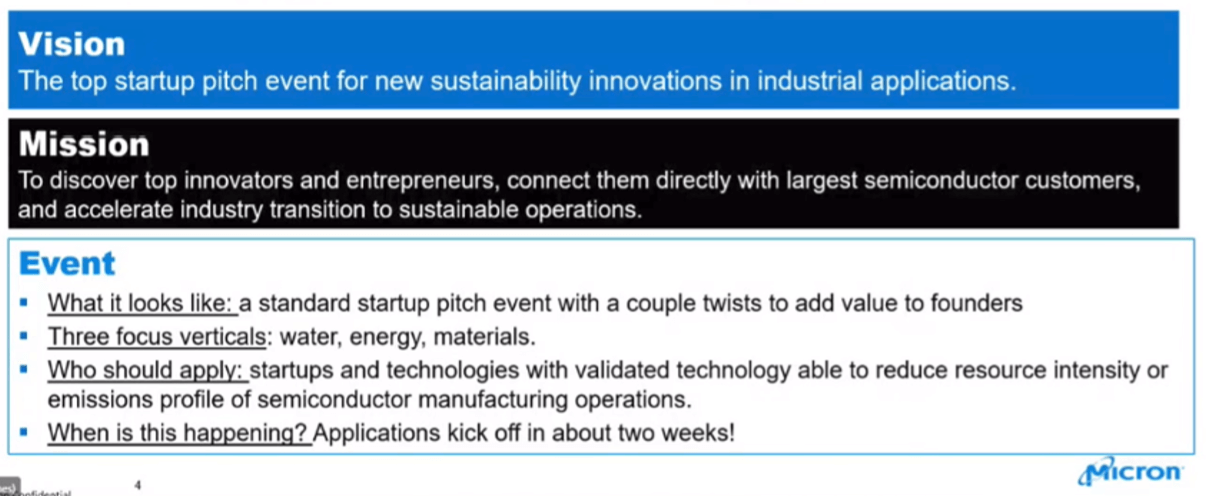
There are three focus areas: energy efficiency, water, and materials use. If this is the first you are hearing of this, the contacts for the pitch contest are John Wei of AMAT, and Andy Byrne of Micron.
Now let’s back up a bit and review the forum.
Ajit Manocha, President, and CEO of SEMI, kicked off the day highlighting the key concerns of climate change, with respect to the temperature rising due to CO2 and other gasses in the atmosphere. Manocha also pointed out that fabs consume a considerable amount of power and water, and that 70 new fabs are coming online in the not-too-distant future. Manocha highlighted that the top semiconductor companies have active programs in place to address some of the process, water, and power issues but that collaboration is needed to better address the problems.
SEMI has formed a sustainability advisory council to help focus on semiconductor sustainability. While this is a good start, what I would like to see SEMI do is create an aggressive set of sustainability standards and goals for the industry to meet. SEMI could help to define what Scope 3 emissions look like for semiconductor manufacture and equipment companies.
One of my pet peeves as an analyst is wading through Environmental, Social, and Governance (ESG) reports where every piece of data is presented differently, and where some companies struggle to define their scope 3 emissions. SEMI could create a roadmap that the industry could use to help not only to define emissions but also the best-known methods that have been implemented to reduce companies’ carbon footprints. This could be a tremendous help to smaller vendors who do not have the resources to have a dedicated sustainability focus or the companies that have had a late start in addressing semiconductor sustainability.
Following SEMI, Chris Libre, Applied Materials, presented on AMAT’s sustainability efforts, sharing both AMAT’s sustainability goals, and their focus on the 1X, 100X, 1000X and 3×30 programs that have been well-publicized since AMAT’s CEO Gary Dickerson kicked off AMAT’s semiconductor sustainability efforts at SEMI 2020.
ST Microelectronics and Intel followed. Pascal Roquet, Corporate Environment & Health Programs, Sr Manager at STMicroelectronics; and Fawn Bergen, Manager of Corporate Sustainability at Intel Corporation; gave overviews of what each company has been doing in the sustainability and conservation space over the past 25 years.
Both ST and Intel are leaders in the semiconductor sustainability efforts and have been encouraging their supply chains to be proactive in their sustainability efforts. The three presenters in this segment all commented on the need for collaboration and partnerships to find ways to reduce energy, water, and chemical consumption. AMAT presented a roadmap for reducing energy consumption through 2030 (Figure 3). Due to the semiconductor industry’s reluctance to change processes, it will be interesting to see how this roadmap gets implemented over time.

Figure 3. AMAT roadmap for reducing energy consumption. (Source: Applied Materials/ Sustainability Venture Forum)
The above presentations set the forum up for the highlight as well as the focus of the day. What do venture capitalists think about sustainability in the semiconductor sector, and how to address the sustainability issues. Some great questions and discussions were bantered about during this session.
- What does it mean to be green?
- Where are the big levers?
- AI in materials and process, how do we get insight earlier?
- Do you choose to go green or do you buy credits?
- What are the tradeoffs of financial sustainability?
We learned that vendors and many startup founders view the semiconductor industry as niche and that the barriers to entry are very high. While that the semiconductor industry creates and uses many greenhouse gases, its overall carbon footprint is less than 500 megatons. And most importantly that at the end of the day the business case has to hold together. What if a company or product doesn’t make money then it is a company or a product?
But are we making progress?
There is actually a lot of progress being made across the industry. The Intel and ST presentations demonstrate the efforts to reduce energy consumption and water use. Semiconductor equipment vendors are looking to find ways to lower power and improve the watts/wafer equation.
And material companies are looking for chemical solutions that reduce the greenhouse gas effect, and how to recycle materials and reduce waste. IMEC pointed out that materials and IC fabrication are the largest contributors to relative CO2 emissions footprint.
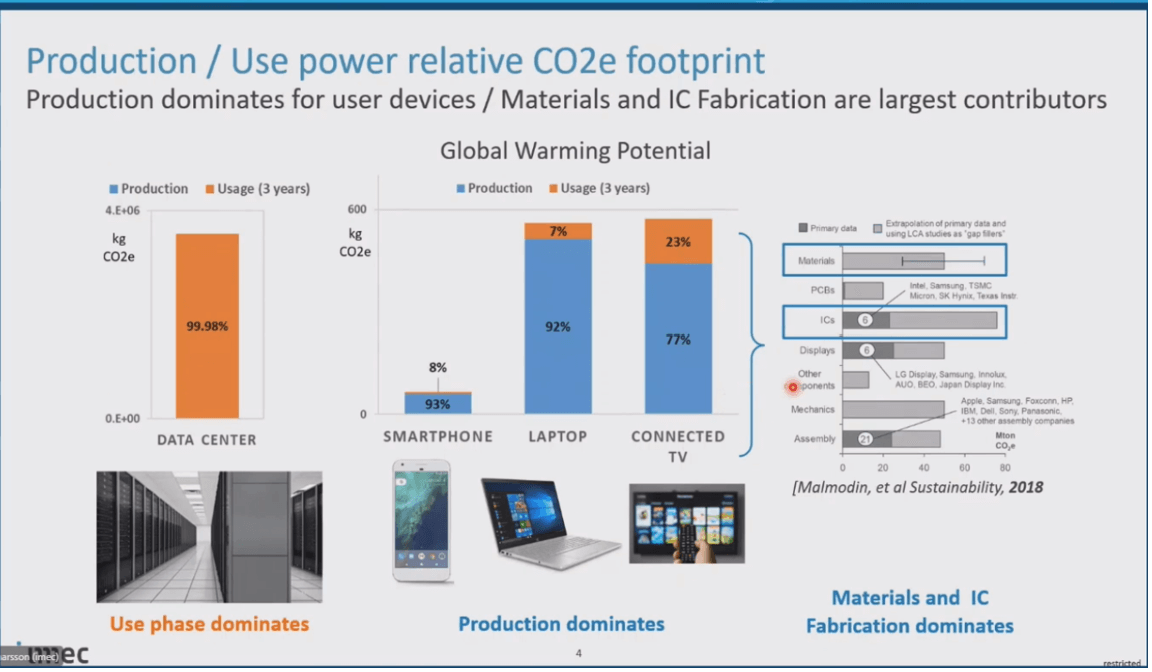
But even more interesting was the presentation by Dr. Katherine Hutchinson, Executive Director, Head-Tech, Strategy & Roadmaps at Office of the CTO at EMD Electronics who pointed out that the semiconductor manufacting industry still recycles very little chemical waste (Figure 5).
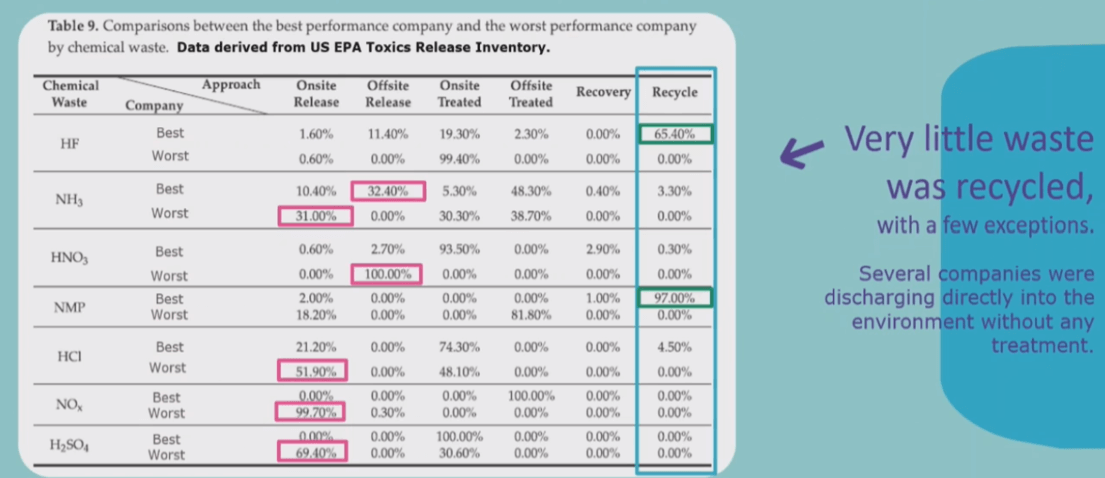
And that the electronics still recycles very little e-waste, and much of that e-waste is sent overseas to countries that may not have the proper resources or facilities to properly recycle e-waste.
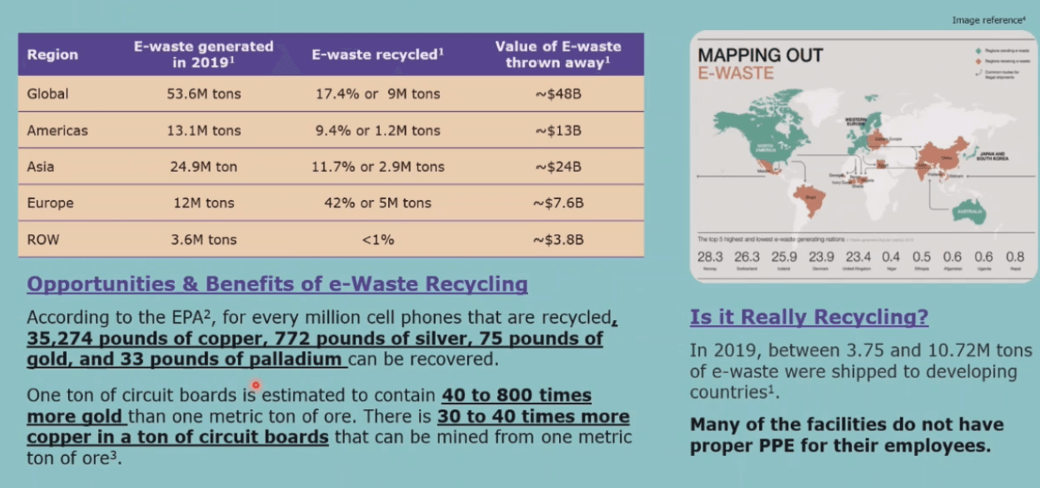
These are two areas that could be addressed quickly if the proper resources were focused on the problem. E-waste recycling could be very profitable in just the metals recycling aspect as you can see from the above slide.
The SEMI Sustainability Venture Forum pointed out that the semiconductor industry has been addressing sustainability for many years. The forum also pointed out that the industry still has a long way to go in reducing waste and greenhouse emissions. The VCs pointed out that we really need to define what green does look like for the semiconductor industry, and that by breaking down each piece of the manufacturing process the industry can optimize the process and reduce energy, materials and water consumption and drive towards a greener future. ~ Dean




